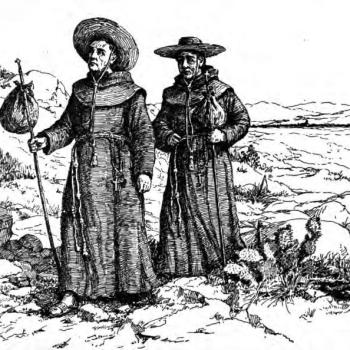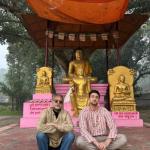I suggested that witchcraft beliefs were actually much slower to decline in the West than we commonly think, and that this has implications for how we assess the impact of Enlightenment modernity. In the US, witchcraft was still a common idea for many rural dwellers through much of the nineteenth century, to the growing mockery of educated urbanites. But what did those urbanites themselves believe?
Back in 2000, I published the book Mystics and Messiahs, about new and fringe religions in American history. I argued that such alternative religions, often esoteric and occult in nature, were a very persistent theme of American religious history, to the point of being near-mainstream, and there has always been a good deal of interchange between “cults” and respectable churches. Those new sects had many beliefs in common through the years, above all a strong commitment to healing and spiritual healing, and also to unlocking the supernatural powers of the individual, such as clairvoyance and psychokinesis. The closer we look at those ideas, the more they look like the sort of occult practice that could get you burned (well, hanged) a couple of centuries earlier.
Very frequently, these ideas were dressed up in the form of science or pseudo-science, best exemplified by the massively popular nineteenth century beliefs in Mesmerism and Spiritualism. If the telegraph could span the world – some call it the Victorian Internet – why should similar human expertise not expand contact into the spiritual realms of the dead? Mesmerism after all claimed to be dealing in version of magnetism.
Incidentally, the New York Review of Books just posted a very good item on Mesmerism in Antebellum America, drawing on the aptly titled book Credulity, by Emily Ogden (2018).
Mesmerism begat Phineas Quimby, which begat Christian Science, which begat New Thought, which contributed mightily to the New Age, not to mention lots of later therapy and self help movements. Early twentieth century Pentecostals commonly faced charges that they were themselves incorporating many of those esoteric ideas and practices into their services and revivals. Moreover, those esoteric ideas laid the way for the reception of Eastern spiritual ideas from the 1870s onward, in the form of Hinduism, Buddhism, and Vedanta. Theosophy owed as much to Mesmerism, New Thought, and Spiritualism as it did to Asian faiths.
In 1910, Ray Stannard Baker wrote his best-selling account of the great spiritual transformation that he believed to be sweeping progressive America:
The new idealism lays its emphasis upon the power of mind over matter, the supremacy of spirit. Its thinkers have interested themselves as never before in the marvelous phenomena of human personality, most of which were contemptuously regarded by the old materialistic science. The wonders of the human mind, the attribute we call consciousness, the self, the relation of mind to mind, telepathy, the strange phenomena of double or multiple consciousness, hypnotism, and all the related marvels, are now crowding for serious attention and promise to open to us new worlds of human knowledge.
So assume you were a sophisticated and educated person in a big city in 1850 or 1900, an elite person of wealth and status. Over and above your church membership, you likely believed in the unseen forces commanded by spiritually gifted individuals, who could control minds and environments by their special powers. Perhaps you thought that healing was likely to be accomplished by mental force, rather than modern medicine. You also held firmly that death was not the end, and that spiritually sensitive mediums could transcend the worlds and dimensions, to communicate with dead souls. More often than not, those healers, mediums and sensitives were women.
At every point, those sophisticated and would-be scientific principles sound very much indeed like the thought world of the pre-modern village, although the vocabulary has changed utterly. The older villages had healers and hex doctors, with their special skills navigating the borders between natural and supernatural, with the special focus on healing, and those older professionals were likely to be female.
By the 1880s, a character in Henry James’s The Bostonians is told that a feminist activist is going to one of her “weird meetings.”
“What kind of meetings do you refer to? You speak as if it were a rendezvous of witches on the Brocken.”
“Well, so it is; they are all witches and wizards, mediums, and spirit-rappers, and roaring radicals.”
It’s a joke, of course, partly at the expense of radical feminists. And yet,those supernatural themes make the witchcraft analogy more plausible. To see just how plausible, consider some scandals that were happening in and around Boston in the very years The Bostonians was written. Mary Baker Eddy was one of the most successful spiritual entrepreneurs of the nineteenth century, but she was also fiercely contentious. Her attacks on rivals and insubordinate followers were given a supernatural basis in the form of Malicious Animal Magnetism, MAM, by which one individual could inflict occult harm on another at a distance. (Animal magnetism was the core idea of Mesmerism). In the 1880s, Eddy accused her enemies of constantly mounting MAM attacks upon her, to the point that she was aptly accused of demonophobia. She even believed that her enemies could stage a “mental assassination.”
The ensuing conflicts gave rise to predictable press reports of “modern witchcraft” and witch-trials, while the Christian Science church’s attempts to control or excommunicate dissidents were discussed in terms of heresy hunts. Again, the names had changed, but a seventeenth century cleric would not have had too much trouble understanding the processes involved.
So here is a suggestion. When we describe the end of Western beliefs in witchcraft, we usually do so by looking at the formal end of witch trials and executions, at various points in the eighteenth centuries. But actual witchcraft beliefs endured long, long after that – both people’s beliefs that they commanded supernatural powers, and popular fears that evil individuals might use those powers for harm. And when actual witchcraft ideas faded, virtually the same ideas resurfaced in pseudo-scientific and metaphysical movements that exercised a vast influence over educated people. In that sense, perhaps witchcraft belief did not die in the eighteenth century, nor the nineteenth, and it remained very much alive through the twentieth. What changed was the rhetoric of spiritual power.
That is all over and above the recurring waves of panic about alleged Satanism and “Ritual Abuse,” which flourished in the 1980s and 1990s. Those reproduced the most florid aspects of the European witch panics in undiluted form, complete with covens and Sabbats. The main difference between those disgraceful episodes and Salem was that someone accused of witchcraft in Massachusetts in 1692 probably had more legal safeguards than did an alleged ritual abuser in California or Minnesota in 1992.
So when did witchcraft belief decline or vanish in the West? I’ll let you know when it happens.
















